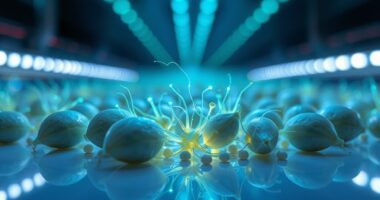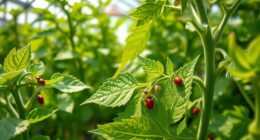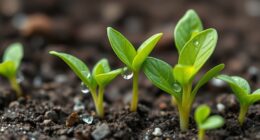Integrating machine vision for pest detection allows you to monitor crops remotely using drones or satellites, providing real-time, high-resolution images that identify pests early through features like size, shape, and color. Advanced imaging techniques, including spectral data, improve accuracy and differentiation. This technology enables continuous surveillance, quick alerts, and targeted interventions, reducing manual effort and crop loss. By adopting these systems, you’ll move toward smarter farming—so keep exploring to see how this innovation can transform your pest management strategies.
Key Takeaways
- Combines remote sensing data from drones or satellites with machine vision algorithms for early pest detection.
- Utilizes advanced imaging techniques, including spectral data, to improve pest identification accuracy.
- Automates real-time pest monitoring, enabling prompt alerts and targeted pest control measures.
- Enhances data collection over time, supporting machine learning improvements and predictive pest management.
- Reduces manual inspection efforts, increasing efficiency and promoting sustainable, precise agriculture practices.

Have you ever wondered how technology can help farmers identify pests more quickly and accurately? With advancements in machine vision, this has become a real possibility. One of the key tools in this process is remote sensing, which allows farmers to monitor large areas of farmland from a distance. Using drones or satellite imagery, remote sensing captures detailed data about crop health and pest presence without the need for manual inspections. This technology provides a bird’s-eye view, enabling you to spot early signs of pest infestations across vast fields, saving time and effort. When integrated with machine vision, remote sensing becomes even more powerful, offering real-time analysis that can pinpoint specific insect activity. Machine vision systems process images captured through remote sensing, automatically identifying pests based on their size, shape, color, and movement patterns. This seamless blend of technologies enhances insect identification, making it more precise than traditional visual inspections. Additionally, the integration of advanced imaging techniques can further improve detection accuracy by capturing different spectral data beyond visible light.
Insect identification is a critical step in managing pest outbreaks effectively. Manual identification often depends on the experience of the farmer or pest control expert, which can be time-consuming and prone to error. Machine vision automates this process by analyzing images and distinguishing pests from other objects or plant parts. High-resolution cameras paired with advanced algorithms can detect even tiny insects, enabling early intervention before pests cause significant damage. This technology not only accelerates identification but also reduces the reliance on chemical treatments by providing accurate data about pest species and infestation levels. As a result, you can make better-informed decisions, applying control measures only when necessary. Furthermore, machine vision systems can be trained to recognize multiple pest species, adapting to different crops and environments, which makes them versatile and scalable.
The integration of remote sensing with machine vision also facilitates continuous monitoring. Instead of sporadic checks, you get ongoing surveillance, alerting you immediately when pests are detected. This proactive approach helps prevent outbreaks from escalating and minimizes crop loss. Plus, as these systems gather more data over time, they improve their accuracy through machine learning, becoming more reliable with each use. Basically, this technology transforms pest management from reactive to proactive, giving you a strategic advantage in protecting your crops. By leveraging remote sensing and sophisticated insect identification algorithms, you not only streamline pest detection but also enhance your overall farming efficiency. It’s a step toward smarter agriculture—more sustainable, precise, and responsive to the challenges you face in maintaining healthy crops.
Frequently Asked Questions
How Does Machine Vision Compare to Manual Pest Identification Accuracy?
Machine vision generally offers higher pest identification accuracy than manual methods, especially when sensor accuracy is high. You don’t rely solely on operator expertise, reducing human error. Automated systems can quickly analyze large areas and detect pests early, improving pest management. While skilled operators are valuable, machine vision provides consistent, objective results, ensuring you catch pests more reliably and efficiently than manual identification alone.
What Are the Costs Involved in Implementing Machine Vision Systems?
You should conduct a thorough cost analysis to understand the expenses involved in implementing machine vision systems. Costs include purchasing cameras, sensors, and processing hardware, as well as software development or licensing fees. Don’t forget ongoing expenses like maintenance and updates. Incorporate these details into your budget planning to guarantee you allocate sufficient funds, balancing initial investments with long-term benefits for accurate pest detection.
Can Machine Vision Detect All Types of Pests Effectively?
You might wonder if machine vision can detect all pest species effectively. While it excels at identifying common pests, detection limitations arise due to pest species diversity, similar appearances, and overlapping features. Sometimes, it struggles with tiny, fast-moving, or camouflaged pests. Consequently, while highly useful, machine vision isn’t foolproof and works best when combined with manual checks and expert knowledge to cover all pest detection needs thoroughly.
What Training Is Required for Operators of Vision-Based Pest Detection?
You need to undergo operator training that covers system calibration and proper use of the vision-based pest detection system. This training helps you understand how to set up the equipment correctly, interpret the results accurately, and troubleshoot issues effectively. Regular practice ensures you stay proficient, and ongoing education keeps you updated on new features or improvements, making pest detection dependable and efficient.
How Does Lighting Affect the Performance of Pest Detection Systems?
Lighting crucially influences your pest detection system’s accuracy. You need ideal light intensity to guarantee clear images, as too little light causes poor visibility, while too much can create glare. Shadow effects also pose challenges, obscuring pests or creating false positives. Adjusting lighting conditions and using consistent, diffuse light sources helps improve detection reliability, enabling your system to identify pests accurately regardless of environmental variations.
Conclusion
Think of machine vision as a vigilant guardian patrolling your fields tirelessly, spotting pests before they cause harm. Just like a watchful eye in the night, it detects threats early, allowing you to act swiftly. By integrating this technology, you’re equipping yourself with an unstoppable ally—an ever-watchful sentinel safeguarding your crops. Embrace this innovation, and let it be the lighthouse guiding you through pest challenges toward a healthier, bountiful harvest.









